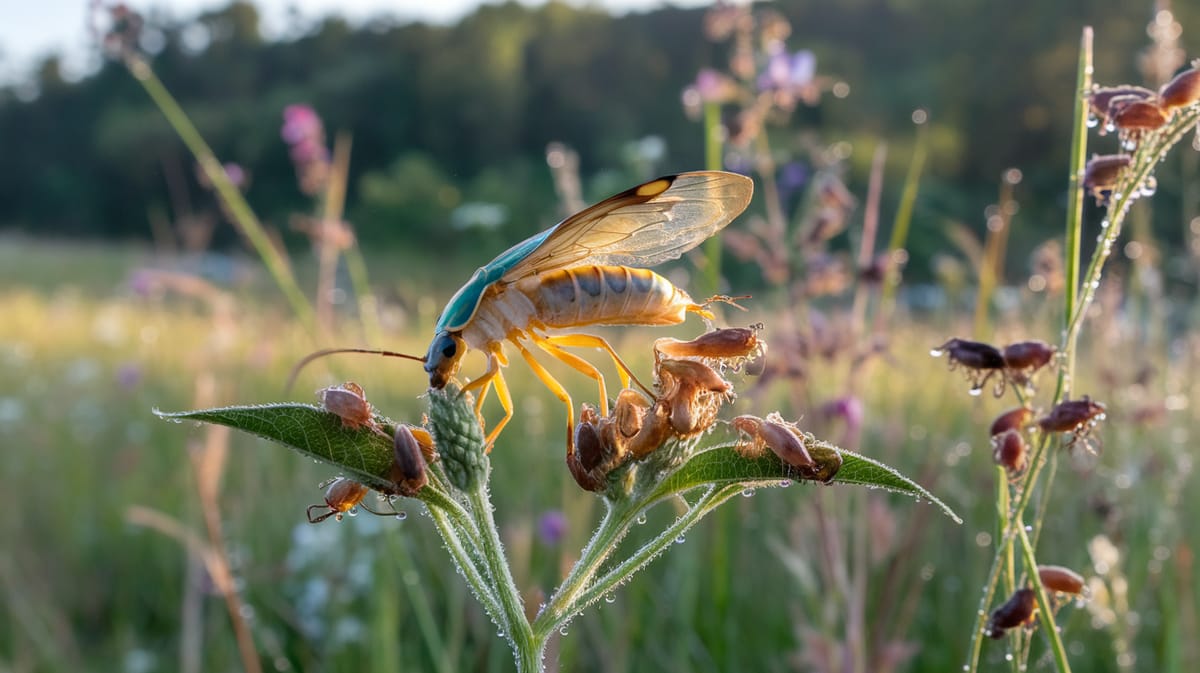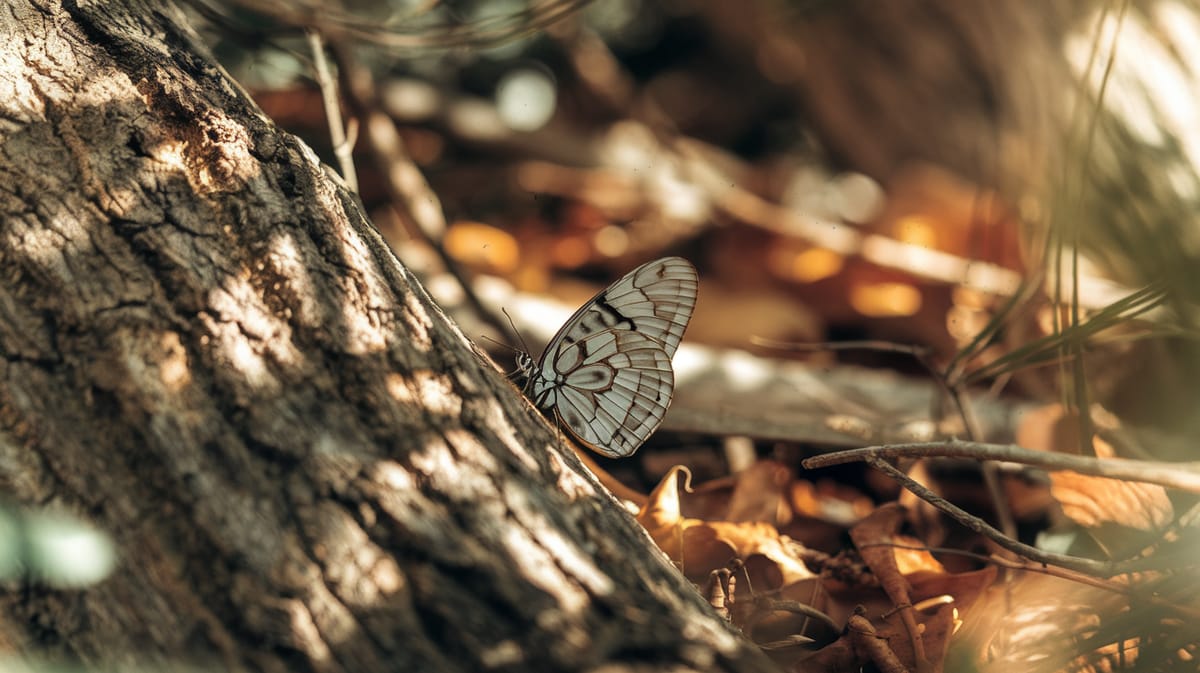Lacewing
Graceful and green, the Lacewing is a natural pest controller, with larvae known as aphid lions due to their voracious appetite for garden pests. Essential for maintaining ecological balance, this insect is as beneficial as it is beautiful.

Key Insights at a Glance
Did You Know?
Taxonomy & Classification
Lacewings are renowned for their delicate, lacy wings and voracious appetite for pest control, making them vital allies in ecosystems worldwide. Let's understand the evolutionary journey and classification of these remarkable predators.
Global Presence
Lacewings belong to the Chrysopidae family, which includes over 1,200 species spread across diverse habitats on every continent except Antarctica.
Evolutionary Adaptations
Originating in the Jurassic period, lacewings have evolved specialized predatory traits, such as acute vision and keen hunting skills, to thrive through significant ecological changes.
Lifecycle and Growth
A remarkable journey of transformation from Egg to Adult.
Egg
Lacewing eggs are laid on slender stalks to protect them from predators and ensure optimum survival.
Larva
Voracious lacewing larvae, known as aphid lions, hunt aggressively and can consume hundreds of aphids daily.
Pupa
Within silken cocoons, the larvae undergo metamorphosis, transforming into adults ready to emerge and continue the lifecycle.
Adult
Adult lacewings, with delicate green wings, are key in pollination and prey on garden pests, supporting plant health.
Dietary Habits
A voracious predator with exceptional adaptability, this insect primarily targets aphids, mites, and other soft-bodied pests through precise hunting techniques.
| DIET TYPE | DESCRIPTION |
|---|---|
| Primary Diet | Consumes mainly aphids, mites, and caterpillars, aiding in pest control within gardens and agricultural fields. |
| Secondary Diet | Occasionally feeds on pollen and nectar, supplementing its diet when prey is less abundant. |
| Occasional | Rarely consumes small arthropods or other insects outside its usual prey range due to scarcity or during migration. |

Behaviour and Adaptations
Discover the extraordinary abilities that make the Lacewing an adept survivor.
Predatory Efficiency
Lacewing larvae, known as aphid lions, consume large numbers of aphids daily.
Camouflage Skills
Adapts by covering themselves with debris for stealth and protection.
Night Vision
Adults are primarily nocturnal, using excellent night vision to hunt effectively.
Ecosystem Impact
Lacewings play a crucial role in maintaining ecological harmony.
Natural Pest Control
Lacewings feed on aphids and other pests, helping manage pest populations naturally.
Food Source
Lacewings serve as prey for birds and bats, supporting the food web.
Pollination Assistants
Lacewings contribute to pollination through their feeding habits on nectar and pollen.
Conservation Challenges
Understanding and addressing the major threats to Lacewing populations.
Chemical Exposure
Pesticides reduce lacewing populations by harming their reproductive and survival rates.
Habitat Loss
Urbanization and agriculture lead to loss of natural lacewing habitats.
Climate Change
Altered climates affect lacewing lifecycle and prey availability.
Frequently Asked Questions
How long do Lacewing live?
Lacewings typically live for about four to six weeks as adults. Their lifespan can vary depending on environmental conditions and food availability. The entire life cycle, from egg to adult, generally spans about four to six weeks as well.
What do Lacewing eat?
Lacewing larvae are voracious predators, feeding primarily on aphids, mites, and other small insects. Adult lacewings usually consume nectar, pollen, and honeydew. Their larvae are beneficial in controlling garden pests.
Are Lacewing poisonous?
Lacewings are not poisonous to humans. They pose no threat and are considered beneficial insects, especially in gardens, due to their predation on pest insects.
Are Lacewing endangered?
Lacewings are not considered endangered. They are common and widespread in many regions, thriving in various habitats including gardens, fields, and forests.
What do Lacewing symbolize?
Lacewings often symbolize protection and renewal. In some cultures, they are seen as guardians of gardens due to their pest control abilities, representing nature's balance and harmony.
Do Lacewing bite?
Lacewings do not bite humans. While their larvae are aggressive predators of small insects, they do not harm humans. Adult lacewings are harmless and do not possess biting or stinging capabilities.
What color are Lacewing?
Lacewings are typically pale green with delicate, translucent wings. Their wings have a lace-like appearance, which gives them their name. Some species may also have brown or golden hues.
Does a Lacewing have wings?
Yes, adult lacewings have two pairs of wings. These wings are transparent, with a delicate, lace-like structure that is a defining feature of the insect.
What does a Lacewing look like?
Lacewings have slender bodies, long antennae, and striking, lace-like wings. They are usually pale green or brown and have large, gold or copper-colored eyes, making them quite distinctive.
Is a Lacewing an insect?
Yes, a lacewing is an insect. It belongs to the order Neuroptera, known for their net-like wing patterns. They are recognized for their role in pest control, making them beneficial insects in many ecosystems.
Related Insects
Discover insects with similar characteristics to Lacewing - including shared habitats, diets, and taxonomic classifications
Share this profile
Help others discover Lacewing
